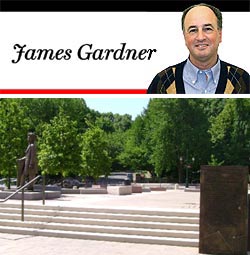Trending
NW corner of Central Park fails to impress
 The Frederick Douglass Circle
The Frederick Douglass CircleMight you wonder what the result of seven long years of construction and delay looks like in the Big Apple — the answer is the vastly underwhelming Frederick Douglass Circle at the northwest corner of Central Park at 110th Street and Central Park West.
With the completion of this circle, Central Park itself is, in a sense, complete. Originally, the park was supposed to have no important architect at its corners. But early in the last century, Grand Army Plaza in front of The Plaza Hotel, and the Maine Monument in Columbus Circle, formed impressive gateways to the southern part of the park. Then in 1993, the Duke Ellington Circle was designed for the northeast corner of the park.
The latest addition is clearly the least successful; perhaps when the trees grow higher, the sense of being caught in traffic will be diminished. But for now, the generally low-lying plaza provides no sense of escape from the surrounding area, no sense of elevation or ennoblement. In part the plaza suffers from the company it keeps. There is a massive gas station just across the street, and absolutely nothing could look good in proximity to the hideous Attica Correctional Facility-style concrete apartment complex Towers on the Park, designed by Bond Ryder James in 1987, that squats across two streets directly to the west.
Inside Frederick Douglass Circle, a standing statue of writer and publisher Frederick Douglass, slightly larger than life and conceived by artist Gabriel Koren, provides an acceptable level of monumentality. The swirling, gyrating, parabolic pavement is covered with images of starry constellations, as well as the words of the fabled orator.
One inspiring thing about the new monument is that skate-boarding is strictly prohibited, and squad cars pass by periodically to ensure that this prohibition is respected. If only a similar decree would be enforced in the new island at Columbus Circle, beside the Time Warner Center, one would not risk physical injury each time one passed through that otherwise estimable public space.
James Gardner, formerly the architecture critic of the New York Sun, writes on the visual arts for several publications.




